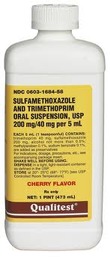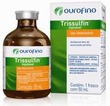Pronunciation
sul-fuh-meth-OX-uh-zole treye-METH-oh-prim - Pronunciation guide
Brand Names
- Equisul-SDT
- Tribessen 400 Oral Paste
- Trissulfin Sulfamethoxazole/Trimethoprim Injection
- Tucoprim Powder
- Uniprim Powder
Description
 Sulfadiazine/Trimethoprim - SMZ/TMP is a potentiated sulfonamide that is one of the most commonly used antimicrobials in the treatment of horses. Used as a combination drug it is more effective and has fewer side effects than when the drugs are used separately. In addition, although neither drug alone kills susceptible bacteria, when used in combination, they are bactericidal.
Sulfadiazine/Trimethoprim - SMZ/TMP is a potentiated sulfonamide that is one of the most commonly used antimicrobials in the treatment of horses. Used as a combination drug it is more effective and has fewer side effects than when the drugs are used separately. In addition, although neither drug alone kills susceptible bacteria, when used in combination, they are bactericidal.
Usage
In horses, SMZ/TMP is used in the treatment of acute strangles, respiratory infections, equine protozoal myeloencephalitis, acute urogenital infections, wound infections, abscesses, and uterine infections. It is also used as a treatment or prevention of post parturient infections, including vaginitis and metritis.
Dosage and Administration
 Sulfadiazine/Trimethoprim Sulfadiazine/Trimethoprim |
||||
|---|---|---|---|---|
| Method | Dosage (click row for calculator) |
Concentration | Period | Duration |
| Oral (Equisul suspension) | 24 mg/kg | 1 mg/mg | Twice daily | 10 days |
| Oral (Tucoprim powder) | 75 mg/kg | 1 mg/mg | Daily | 5 to 7 days |
| Oral (paste) | 75 mg/kg | 15000 mg/syringe 4 | Daily | 5 to 7 days |
| Intraveneous or Intramuscular injection | 24 mg/kg 1 | 480 mg/ml 5 | Daily | 5 to 7 days |
Notes:
|
||||
Side Effects
Hypersensitivity reactions and hematologic effects, including anemias, thrombocytopenia, or leukopenias may occur.
The most common side effect is diarrhea.
When given as an injection, tissue damage at the site of the injection has been noted, and itching and other allergic reactions have occurred.
Rare fatalities have been reported after intravenous SMZ/TMP injections, but these reports are anecdotal and the direct cause is difficult to determine.
Precautions
SMZ/TMP should not be used in horses with liver damage, blood conditions, or in horses with a history of sulfonamide sensitivity.
Long-term usage should include periodic hematologic monitoring.
Transient pruritis has been noted after IV injection.
Sulfamethoxazole/Trimethoprim is not FDA-approved for use in horses, but it is commonly used and an accepted practice. Trimethoprim sulfadiazine is FDA-approved for use in horses.
SMZ/TMP is a prescription drug, restricted to use by or on the lawful written or oral order of a licensed veterinarian.
SMZ/TMP is not permitted in drug-free competitions. Check with the appropriate regulatory body regarding rules and regulations in competition horses.
Interactions
Increased risk of cardiac arrhythmia exists when used with detomidine, halthane, romifidine, or xylazine. (Vetstream).
SMZ/TMP can increase clotting time in horses on oral anticoagulants, such as warfarin.
Antacids can decrease the absorption of SMZ/TMP. Dosing of these medications should be separated by two hours.
Overdose
SMZ/TMP is generally a safe drug and no specific information is given on overdose in horses.
Images
 Sulfamethoxazole/Trimethoprim Suspension Liquic
Sulfamethoxazole/Trimethoprim Suspension Liquic
 Trissulfin Sulfamethoxazole/Trimethoprim Injection,
Trissulfin Sulfamethoxazole/Trimethoprim Injection,
